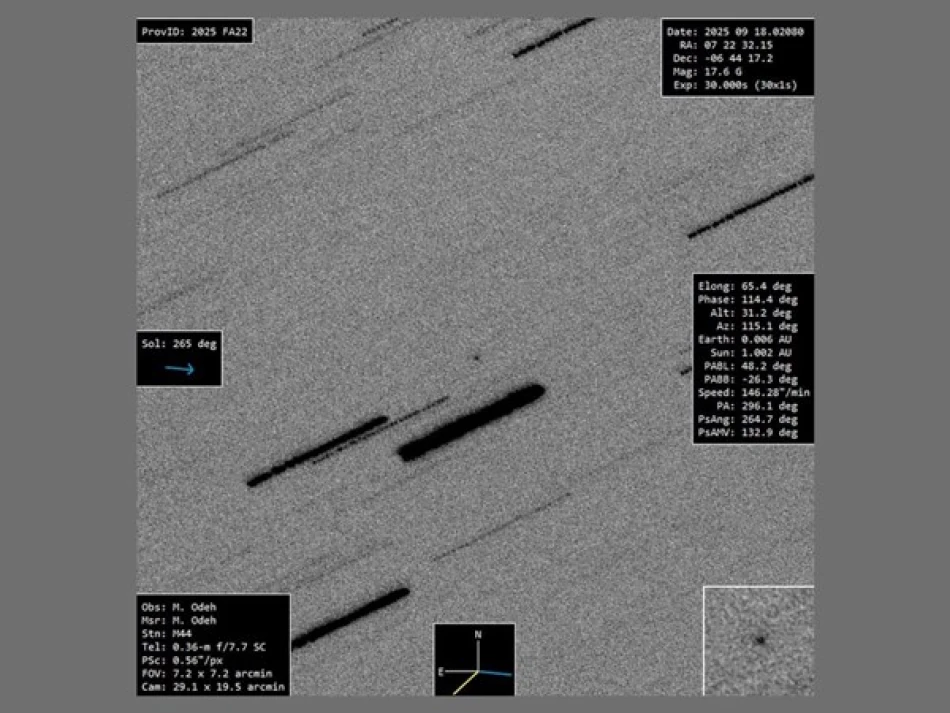
Stargazers Spot Asteroid's Close Encounter with Earth
UAE Observatory Joins Global Defense Against Asteroid Threats in Major Space Surveillance Breakthrough
The UAE has positioned itself as a key player in planetary defense after its Abu Dhabi desert observatory successfully tracked and photographed a 200-meter asteroid just seven hours before its closest approach to Earth. This achievement marks a significant milestone for the Arab world's participation in global space security initiatives and demonstrates the Emirates' growing capabilities in critical space surveillance operations.
Precision Tracking in the Desert
The Al-Khatm Astronomical Observatory, operated by the International Astronomy Center, captured detailed images of asteroid FA22 at 4:40 AM local time on Thursday. The space rock, discovered on March 29, passed Earth at a distance of 826,000 kilometers—roughly twice the distance between Earth and the Moon—at 07:41 UTC.
According to Engineer Mohammed Shawkat Odeh, director of the International Astronomy Center, the asteroid was moving at an exceptional speed of 2.5 arc minutes per minute, equivalent to crossing the Moon's diameter every 12 minutes. This rapid movement made the observation extremely challenging, requiring sophisticated tracking capabilities and precise timing.
Advanced Astrometric Analysis
The observatory team conducted comprehensive astrometric measurements, precisely determining the celestial object's position and monitoring its positional changes over time. This data contributes crucial information to global tracking networks that monitor potentially hazardous asteroids.
Strategic Implications for Regional Space Capabilities
The successful observation represents more than a technical achievement—it signals the UAE's emergence as a reliable partner in international space defense efforts. The country's investment in advanced astronomical infrastructure mirrors similar initiatives by other regional powers seeking to establish themselves in the space domain.
This development aligns with the UAE's broader space ambitions, following successful missions to Mars and ongoing lunar exploration programs. By contributing to asteroid tracking, the Emirates demonstrates its commitment to global space security while building domestic expertise in critical space surveillance technologies.
Global Context: The Growing Asteroid Defense Network
The observation was conducted as part of a coordinated campaign by the International Asteroid Warning Network (IAWN), jointly managed by NASA and the European Space Agency (ESA). This network represents humanity's primary defense mechanism against potentially hazardous asteroids, coordinating observations from major observatories worldwide.
The timing is particularly significant as space agencies worldwide are intensifying efforts to catalog and track near-Earth objects. Recent successful asteroid deflection missions, including NASA's DART mission, have proven that humanity can potentially alter asteroid trajectories, making early detection and precise tracking more crucial than ever.
Building Regional Expertise
The UAE's participation in IAWN operations provides valuable training for local scientists and engineers in advanced data processing, analysis, and space surveillance techniques. This knowledge transfer is essential for developing indigenous capabilities in space situational awareness—a critical component of national space security.
Investment Implications and Future Outlook
The successful tracking operation validates the UAE's strategic investments in space infrastructure and positions the country as an attractive partner for international space collaborations. As commercial space activities expand and asteroid mining ventures emerge, nations with proven tracking capabilities will likely play central roles in space resource management and security.
The observatory's quick response and high-quality data delivery to IAWN networks reinforces the UAE's reputation for reliable scientific partnerships, potentially opening doors to more advanced space cooperation agreements with major space powers.
This achievement also highlights the growing importance of distributed global observation networks. As asteroid detection becomes increasingly automated and AI-driven, ground-based observatories in strategic locations like the UAE's desert facilities will remain essential for verification and detailed analysis of potentially threatening objects.
Most Viewed News

 Layla Al Mansoori
Layla Al Mansoori






